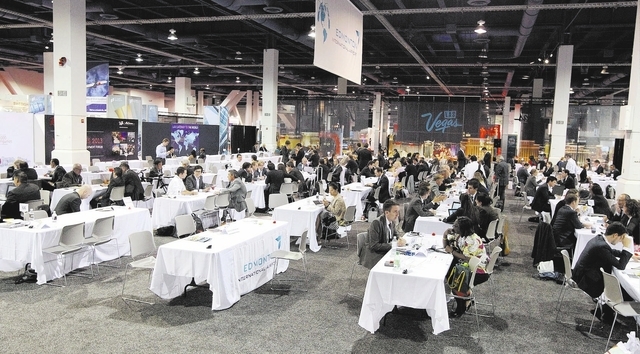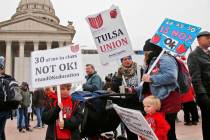A lot of wooing went on at World Routes conference
By the second day of the World Routes conference, the printed PowerPoints and trinkets from cities all over the world pile up on the 355 tables for airlines.
One table had a foam football from Ireland and small Panda dolls from China they had given as forget-me-nots to Southwest Airlines, which has never flown over an ocean going east or west. But so it went, delegation after delegation tried to persuade airlines to send some planes their way in sales sessions that lasted 20 minutes.
Some of the tables were scheduled for more than three dozen pitches during the three days of the conference running Oct. 6-8, with larger airlines having booked several tables. How did they keep it all straight, especially since many of the cities recited lots of numbers that all pointed to the same conclusions, reinforced by the liberal use of tablets?
“We have a system for reviewing all of them when we get home and making follow-up contacts,” said Vijay Bathija, vice president, commercial for Rouge, the new leisure division for Air Canada. “It helps that everybody brings things in electronic form.”
He pointed to one member of the Air Canada team as designated to take home all the mementos in his luggage because he was the new guy.
World Routes is not so much a forum for rewriting the schedule because of a sudden epiphany about the market, as a chance to get acquainted, Southwest senior director of route planning John Kirby said. “It is a chance to set up relationships for when we want to move on something.”
That can pay off for knowing who to call for more research into a potential destination or how to deal with logistics at a candidate airport. “We do a lot of reconnaissance here,” he said.
This year, because it was the first time World Routes has come to the United States, he saw representatives from numerous small or midsized cities for the first time, because they do not have the budget to go to airline headquarters for single visits or attend the conference in places such as Abu Dhabi, last year’s host.
As for places such as McCarran International, served by Southwest for three decades, there are no secrets about data such as passenger demand and average fares. Instead, he said, it is more a chance to “get updates on what is happening in the community.”
How much of an impression that makes is hard to tell. Las Vegas visitor industry leaders used the conference to pound out a steady beat of good news about the city’s attractions and new ones such as Caesars Entertainment’s Linq retail and entertainment center paired with a giant observation wheel. Yet passenger counts at McCarran are flat for the year, because of the 0.6 percent decline in domestic traffic through August carrying more weight than the 4.9 percent gain on the international side. Southwest, the largest carrier with a 40 percent market share, is up only 1.9 percent for the year to date and fell in August.
It wasn’t as if the conference was a blur of statistics. With only 2,800 attendees, less than a tenth of the big shows that regularly stop in Las Vegas, refeshments were easy to come by. At the big conventions, exhibitors generally pour the good stuff in the meeting rooms for serious clients, so as not to bust their budgets. World Routes put it out there for anyone with a badge.
Several Belgian beers were on tap at the Brussels booth. Hanover, Germany poured Jaegermeister; Lyon, France brought plenty of cabernet sauvignon; and the province of Saskatchewan mixed morning cocktails for anyone who wanted to stop and chat with a couple of Mounties.
For delegates who shun alcohol during working hours, Chinese cities, Marrakesh, Morocco, and Incheon, Korea, brewed tea. Ras al Khaimah of the United Arab Emirates and Vienna brought their own distinctive coffee blends. Vienna also served slices of its signature chocolate cake, Sacher torte, a dessert to go with the satay chicken at the nearby Malaysia booth or sushi from Norway, both of which attracted steady lines.
Complaining about deteriorating airline service has almost become an industry unto itself. Why does nothing happen?
An answer lies in the note put out by analyst Hunter Keay of Wolfe Research in New York. In reviewing Spirit Airlines, renowned for the industry’s tightest leg room and charging extra for almost everything, he wrote, “(T)his business model is functioning. (Spirit) fills its planes despite being excoriated on blogs and consistently reporting below average on-time performance because its fares are low and over 99 percent of its flights are completed. We see many years of growth options for (Spirit)… .”














